翻译史考试试题学习资料
- 格式:doc
- 大小:37.00 KB
- 文档页数:6
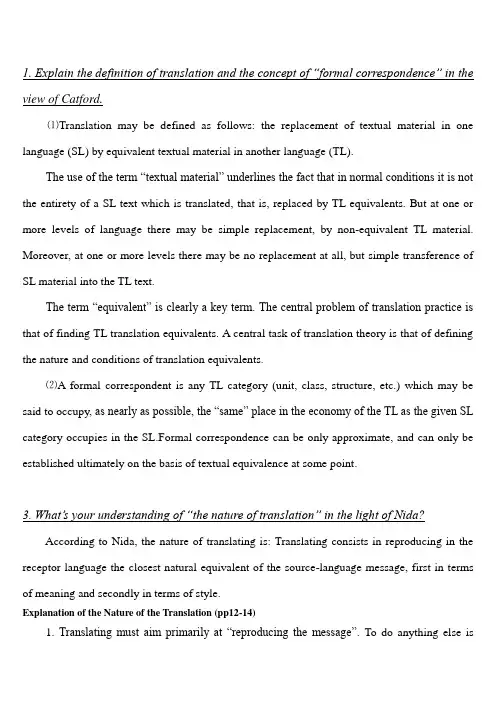
1. Explain the definition of translation and the concept of “formal correspondence” in the view of Catford.⑴Translation may be defined as follows: the replacement of textual material in one language (SL) by equivalent textual material in another language (TL).The use of the term “textual material” underlines the fact that in normal conditions it is not the entirety of a SL text which is translated, that is, replaced by TL equivalents. But at one or more levels of language there may be simple replacement, by non-equivalent TL material. Moreover, at one or more levels there may be no replacement at all, but simple transference of SL material into the TL text.The term “equivalent” is clearly a key term. The central problem of translation practice is that of finding TL translation equivalents. A central task of translation theory is that of defining the nature and conditions of translation equivalents.⑵A formal correspondent is any TL category (unit, class, structure, etc.) which may be said to occupy, as nearly as possible, the “same” place in the economy of the TL as the given SL category occupies in the SL.Formal correspondence can be only approximate, and can only be established ultimately on the basis of textual equivalence at some point.3. What’s your understanding of “the nature of translation” in the light of Nida?According to Nida, the nature of translating is: Translating consists in reproducing in the receptor language the closest natural equivalent of the source-language message, first in terms of meaning and secondly in terms of style.Explanation of the Nature of the Translation (pp12-14)1. Translating must aim primarily at “reproducing the message”.To do anything else isessentially false to one’s task as a translator.(aim)2. The translator must strive for equivalence rather than identity. In a sense this is just another way of emphasizing the reproduction of the message rather than the conservation of the form of the utterance. (equivalence)3. The best translation does not sound like a translation. It should studiously avoid “translationese”—formal fidelity, with resulting unfaithfulness to the content and the impact of the message.(natural)4. A conscientious translator will want the closest natural equivalent because of the cultural differences.5. Meaning must be given priority, for it is the content of the message which is of prime importance for translating, and to do anything else is essentially false to one’s task as a translator.6. Style is said secondary to content, but it is still important. One should not translate poetry as though it were prose, nor expository material as though it were straight narrative.5. Explain “semantic translation” and “communicative translation” proposed by Newmark.①Semantic translation attempts to render, as closely as the semantic and syntactic structures of the second language allow, the exact contextual meaning of the original. Communicative translation attempts to produce on its readers an effect as close as possible to that obtained on the readers of the original.②Generally, a semantic translation tends to be more complex, more awkward, moredetailed, more concentrated, and pursues the thought-processes rather than the intention of the transmitter. It tends to overtranslate, to be more specific than the original, to include more meanings in its search for one nuance of meaning. A communicative translation is likely to be smoother, simpler, clearer, more direct, more conventional, conforming to a particular register of language, tending to undertranslate, i.e. to use more generic, hold-all terms in difficult passages.③A semantic translation is out of time and local space, where a communicative translation is ephemeral and rooted in its context. A semantic translation attempts to preserve its author’s idiolect, his peculiar form of expression. It relates to “expressive” function of language, where communicative translation responds to the vocative function of language.④One basic difference between the two methods is that where there is a conflict, the communicative must emphasize the “force” rather than the content of t he message, e.g.:Beware of the dog!1) 当心狗!2)“狗咬人” 或“狗很凶”Keep off the grass!1)勿踏草坪!2)不要在草坪上行走。
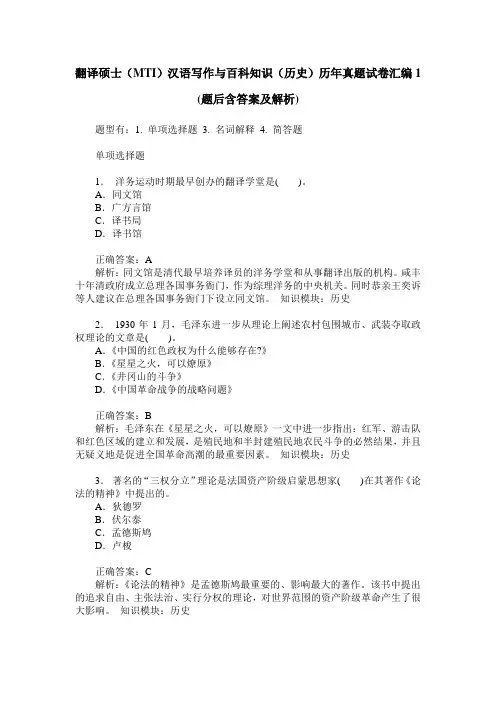
翻译硕士(MTI)汉语写作与百科知识(历史)历年真题试卷汇编1(题后含答案及解析)题型有:1. 单项选择题 3. 名词解释 4. 简答题单项选择题1.洋务运动时期最早创办的翻译学堂是( )。
A.同文馆B.广方言馆C.译书局D.译书馆正确答案:A解析:同文馆是清代最早培养译员的洋务学堂和从事翻译出版的机构。
咸丰十年清政府成立总理各国事务衙门,作为综理洋务的中央机关。
同时恭亲王奕诉等人建议在总理各国事务衙门下设立同文馆。
知识模块:历史2.1930年1月,毛泽东进一步从理论上阐述农村包围城市、武装夺取政权理论的文章是( )。
A.《中国的红色政权为什么能够存在?》B.《星星之火,可以燎原》C.《井冈山的斗争》D.《中国革命战争的战略问题》正确答案:B解析:毛泽东在《星星之火,可以燎原》一文中进一步指出:红军、游击队和红色区域的建立和发展,是殖民地和半封建殖民地农民斗争的必然结果,并且无疑义地是促进全国革命高潮的最重要因素。
知识模块:历史3.著名的“三权分立”理论是法国资产阶级启蒙思想家( )在其著作《论法的精神》中提出的。
A.狄德罗B.伏尔泰C.孟德斯鸠D.卢梭正确答案:C解析:《论法的精神》是孟德斯鸠最重要的、影响最大的著作。
该书中提出的追求自由、主张法治、实行分权的理论,对世界范围的资产阶级革命产生了很大影响。
知识模块:历史4.“完璧归赵”“怒发冲冠”等成语出于蔺相如的故事,这个故事来自历史书( )。
A.《左传》B.《战国策》C.《史记》D.《汉书》正确答案:C解析:“完璧归赵”“怒发冲冠”出自西汉司马迁《史记.廉颇蔺相如列传》。
知识模块:历史5.古代中国,在不同的历史时期,曾多次和其他国家有过对外交流。
汉武帝派( )出使西域,是中国有史以来的第一次中外交流。
A.徐光启B.郑和C.张骞D.玄奘正确答案:C解析:徐光启和郑和是明朝人,玄奘是唐朝人,张骞出使西域开辟了著名的“丝绸之路”。
知识模块:历史6.中国古代医药学著作现存约8000多种,形成了完整的理论体系。
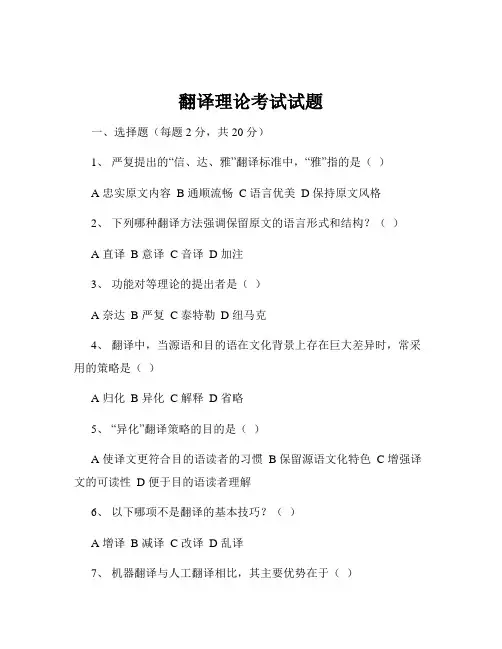
翻译理论考试试题一、选择题(每题 2 分,共 20 分)1、严复提出的“信、达、雅”翻译标准中,“雅”指的是()A 忠实原文内容B 通顺流畅C 语言优美D 保持原文风格2、下列哪种翻译方法强调保留原文的语言形式和结构?()A 直译B 意译C 音译D 加注3、功能对等理论的提出者是()A 奈达B 严复C 泰特勒D 纽马克4、翻译中,当源语和目的语在文化背景上存在巨大差异时,常采用的策略是()A 归化B 异化C 解释D 省略5、“异化”翻译策略的目的是()A 使译文更符合目的语读者的习惯B 保留源语文化特色C 增强译文的可读性D 便于目的语读者理解6、以下哪项不是翻译的基本技巧?()A 增译B 减译C 改译D 乱译7、机器翻译与人工翻译相比,其主要优势在于()A 翻译质量高B 速度快C 能处理复杂语境D 更具创造性8、翻译“Love me, love my dog”,下列哪个译文最恰当?()A 爱我,爱我的狗B 爱屋及乌C 喜欢我,喜欢我的狗D 爱我就爱我的狗9、在商务翻译中,最重要的原则是()A 准确性B 简洁性C 专业性D 灵活性10、翻译诗词时,常常需要考虑的因素是()A 韵律和节奏B 词汇的选择C 语法结构D 以上都是二、简答题(每题 10 分,共 30 分)1、请简述直译和意译的区别,并举例说明。
直译是指在翻译过程中,既保持原文的内容,也尽可能保留原文的形式和结构。
例如,将“paper tiger”直译为“纸老虎”。
意译则更注重传达原文的意思,而不拘泥于原文的形式和结构。
比如,“It rains cats and dogs”意译为“倾盆大雨”,而不是直译为“下猫和狗”。
2、谈谈你对翻译中文化因素的理解,以及如何处理文化差异。
在翻译中,文化因素至关重要。
不同的语言往往承载着各自独特的文化内涵。
比如,一些习语、典故、宗教信仰等在不同文化中可能有不同的理解和象征意义。
处理文化差异时,可以采用归化和异化的策略。
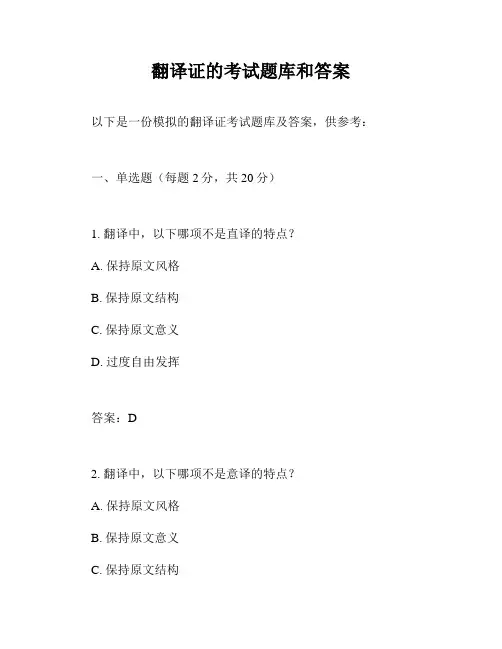
翻译证的考试题库和答案以下是一份模拟的翻译证考试题库及答案,供参考:一、单选题(每题2分,共20分)1. 翻译中,以下哪项不是直译的特点?A. 保持原文风格B. 保持原文结构C. 保持原文意义D. 过度自由发挥答案:D2. 翻译中,以下哪项不是意译的特点?A. 保持原文风格B. 保持原文意义C. 保持原文结构D. 灵活处理原文答案:C3. 翻译中,以下哪项不是增译的特点?A. 增加原文没有的信息B. 增加原文隐含的信息C. 增加原文省略的信息D. 增加原文多余的信息答案:D4. 翻译中,以下哪项不是减译的特点?A. 省略原文多余的信息B. 省略原文隐含的信息C. 省略原文省略的信息D. 省略原文没有的信息答案:D5. 翻译中,以下哪项不是变译的特点?A. 改变原文结构B. 改变原文风格C. 改变原文意义D. 保持原文意义答案:C6. 翻译中,以下哪项不是倒译的特点?A. 倒置原文语序B. 倒置原文结构C. 倒置原文意义D. 保持原文意义答案:C7. 翻译中,以下哪项不是分译的特点?A. 分开翻译原文B. 分开翻译原文结构C. 分开翻译原文意义D. 合并翻译原文答案:D8. 翻译中,以下哪项不是合译的特点?A. 合并翻译原文B. 合并翻译原文结构C. 合并翻译原文意义D. 分开翻译原文答案:D9. 翻译中,以下哪项不是换译的特点?A. 替换原文词汇C. 替换原文意义D. 保持原文意义答案:C10. 翻译中,以下哪项不是反译的特点?A. 反转原文语序B. 反转原文结构C. 反转原文意义D. 保持原文意义答案:C二、多选题(每题3分,共15分)11. 翻译中,以下哪些属于直译的特点?()A. 保持原文风格C. 保持原文意义D. 过度自由发挥答案:ABC12. 翻译中,以下哪些属于意译的特点?()A. 保持原文风格B. 保持原文意义C. 保持原文结构D. 灵活处理原文答案:ABD13. 翻译中,以下哪些属于增译的特点?()A. 增加原文没有的信息B. 增加原文隐含的信息C. 增加原文省略的信息D. 增加原文多余的信息答案:ABC14. 翻译中,以下哪些属于减译的特点?()A. 省略原文多余的信息B. 省略原文隐含的信息C. 省略原文省略的信息D. 省略原文没有的信息答案:ABC15. 翻译中,以下哪些属于变译的特点?()A. 改变原文结构B. 改变原文风格C. 改变原文意义D. 保持原文意义三、判断题(每题2分,共20分)16. 直译就是完全按照原文的字面意思翻译。
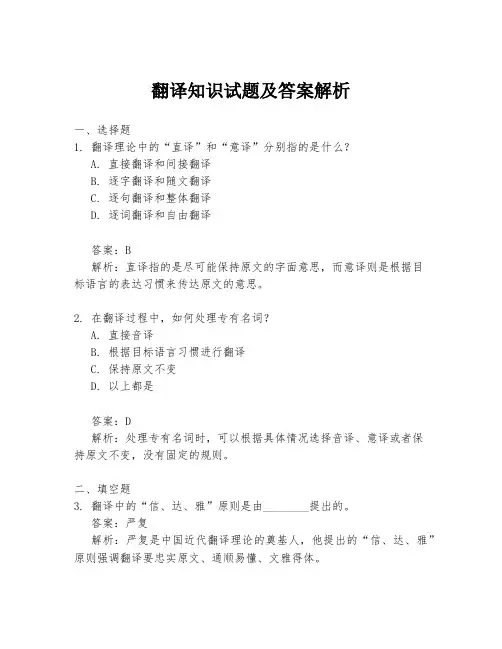
翻译知识试题及答案解析一、选择题1. 翻译理论中的“直译”和“意译”分别指的是什么?A. 直接翻译和间接翻译B. 逐字翻译和随文翻译C. 逐句翻译和整体翻译D. 逐词翻译和自由翻译答案:B解析:直译指的是尽可能保持原文的字面意思,而意译则是根据目标语言的表达习惯来传达原文的意思。
2. 在翻译过程中,如何处理专有名词?A. 直接音译B. 根据目标语言习惯进行翻译C. 保持原文不变D. 以上都是答案:D解析:处理专有名词时,可以根据具体情况选择音译、意译或者保持原文不变,没有固定的规则。
二、填空题3. 翻译中的“信、达、雅”原则是由________提出的。
答案:严复解析:严复是中国近代翻译理论的奠基人,他提出的“信、达、雅”原则强调翻译要忠实原文、通顺易懂、文雅得体。
4. 在翻译文学作品时,译者需要考虑的一个重要因素是________。
答案:文化差异解析:文学作品中往往蕴含丰富的文化内涵,译者在翻译时需要充分考虑文化差异,以确保译文能够传达原作的文化内涵和艺术魅力。
三、简答题5. 简述翻译中“忠实性”的重要性。
答案:忠实性是指翻译时要尽可能保持原文的意思和风格。
忠实性是翻译的基本原则之一,它确保了翻译作品的准确性和可靠性。
在翻译过程中,译者需要忠实于原文的内容、风格和作者的意图,同时也要考虑到目标语言的表达习惯,做到既忠实又通顺。
四、论述题6. 论述翻译中如何处理语言的模糊性和多义性。
答案:语言的模糊性和多义性是翻译中的常见问题。
处理这些问题时,译者首先需要准确理解原文的意图和上下文,然后根据目标语言的表达习惯和文化背景,选择最合适的译文。
在必要时,译者可以采用注释、脚注或者附加解释的方式来帮助读者理解。
此外,译者还应该具备一定的语言敏感性和文化素养,以便更好地处理语言的模糊性和多义性。
五、翻译实践题7. 将以下中文句子翻译成英文,并简要说明翻译策略。
中文句子:他的话让人深思。
英文翻译:His words are thought-provoking.翻译策略:在翻译这句话时,采用了意译的方法。
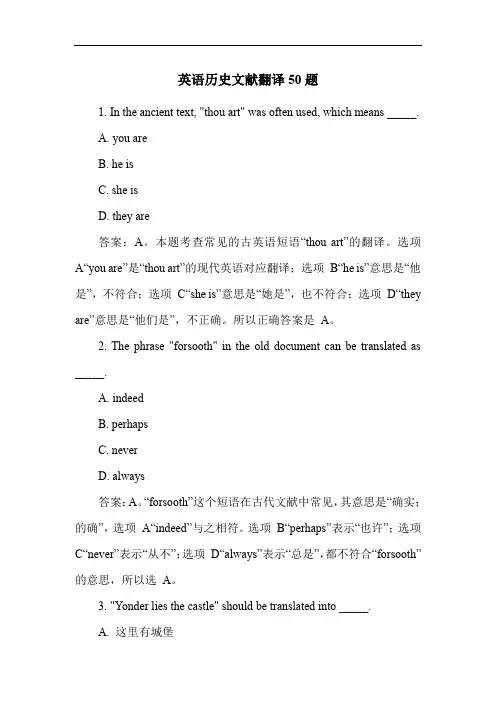
英语历史文献翻译50题1. In the ancient text, "thou art" was often used, which means _____.A. you areB. he isC. she isD. they are答案:A。
本题考查常见的古英语短语“thou art”的翻译。
选项A“you are”是“thou art”的现代英语对应翻译;选项B“he is”意思是“他是”,不符合;选项C“she is”意思是“她是”,也不符合;选项D“they are”意思是“他们是”,不正确。
所以正确答案是A。
2. The phrase "forsooth" in the old document can be translated as _____.A. indeedB. perhapsC. neverD. always答案:A。
“forsooth”这个短语在古代文献中常见,其意思是“确实;的确”,选项A“indeed”与之相符。
选项B“perhaps”表示“也许”;选项C“never”表示“从不”;选项D“always”表示“总是”,都不符合“forsooth”的意思,所以选A。
3. "Yonder lies the castle" should be translated into _____.A. 这里有城堡B. 那里有城堡C. 远处有城堡D. 旁边有城堡答案:B。
“yonder”意思是“那里;那边”,所以“Yonder lies the castle”应翻译为“那里有城堡”,选项B 正确。
选项 A 中“这里”对应的英语是“here”;选项C“远处”常用“far away”等表达;选项D“旁边”常用“beside”等词,均不符合题意。
4. The word "anon" in the historical text could mean _____.A. soonB. lateC. neverD. often答案:A。
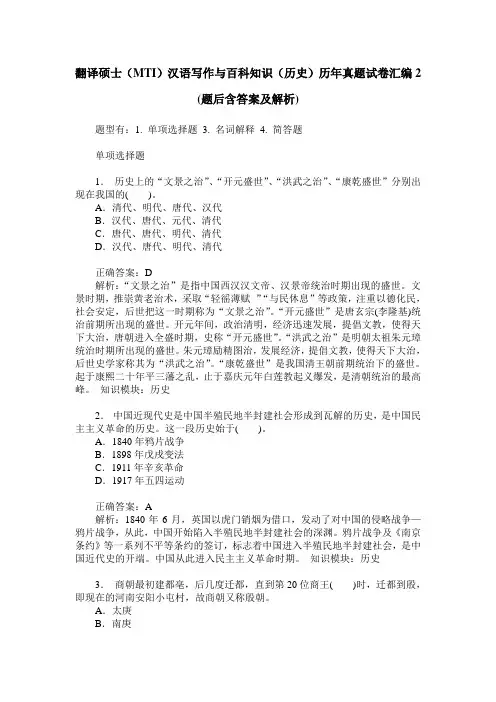
翻译硕士(MTI)汉语写作与百科知识(历史)历年真题试卷汇编2(题后含答案及解析)题型有:1. 单项选择题 3. 名词解释 4. 简答题单项选择题1.历史上的“文景之治”、“开元盛世”、“洪武之治”、“康乾盛世”分别出现在我国的( )。
A.清代、明代、唐代、汉代B.汉代、唐代、元代、清代C.唐代、唐代、明代、清代D.汉代、唐代、明代、清代正确答案:D解析:“文景之治”是指中国西汉汉文帝、汉景帝统治时期出现的盛世。
文景时期,推崇黄老治术,采取“轻徭薄赋”“与民休息”等政策,注重以德化民,社会安定,后世把这一时期称为“文景之治”。
“开元盛世”是唐玄宗(李隆基)统治前期所出现的盛世。
开元年间,政治清明,经济迅速发展,提倡文教,使得天下大治,唐朝进入全盛时期,史称“开元盛世”。
“洪武之治”是明朝太祖朱元璋统治时期所出现的盛世。
朱元璋励精图治,发展经济,提倡文教,使得天下大治,后世史学家称其为“洪武之治”。
“康乾盛世”是我国清王朝前期统治下的盛世。
起于康熙二十年平三藩之乱,止于嘉庆元年白莲教起义爆发,是清朝统治的最高峰。
知识模块:历史2.中国近现代史是中国半殖民地半封建社会形成到瓦解的历史,是中国民主主义革命的历史。
这一段历史始于( )。
A.1840年鸦片战争B.1898年戊戌变法C.1911年辛亥革命D.1917年五四运动正确答案:A解析:1840年6月,英国以虎门销烟为借口,发动了对中国的侵略战争—鸦片战争,从此,中国开始陷入半殖民地半封建社会的深渊。
鸦片战争及《南京条约》等一系列不平等条约的签订,标志着中国进入半殖民地半封建社会,是中国近代史的开端。
中国从此进入民主主义革命时期。
知识模块:历史3.商朝最初建都亳,后几度迁都,直到第20位商王( )时,迁都到殷,即现在的河南安阳小屯村,故商朝又称殷朝。
A.太庚B.南庚C.祖庚D.盘庚正确答案:D解析:商朝(约前1556~前1046年)是中国历史上的第二个朝代,由商汤灭夏后在毫(今河南商丘)建立,商纣王于牧野之战被周武王击败,商朝灭亡。
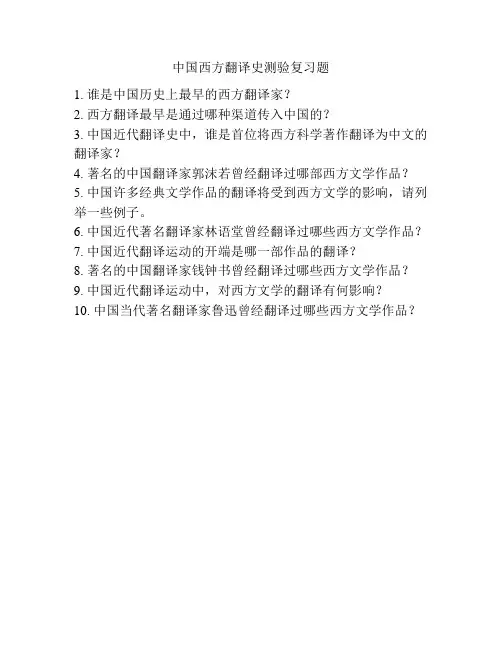
中国西方翻译史测验复习题
1. 谁是中国历史上最早的西方翻译家?
2. 西方翻译最早是通过哪种渠道传入中国的?
3. 中国近代翻译史中,谁是首位将西方科学著作翻译为中文的翻译家?
4. 著名的中国翻译家郭沫若曾经翻译过哪部西方文学作品?
5. 中国许多经典文学作品的翻译将受到西方文学的影响,请列举一些例子。
6. 中国近代著名翻译家林语堂曾经翻译过哪些西方文学作品?
7. 中国近代翻译运动的开端是哪一部作品的翻译?
8. 著名的中国翻译家钱钟书曾经翻译过哪些西方文学作品?
9. 中国近代翻译运动中,对西方文学的翻译有何影响?
10. 中国当代著名翻译家鲁迅曾经翻译过哪些西方文学作品?。
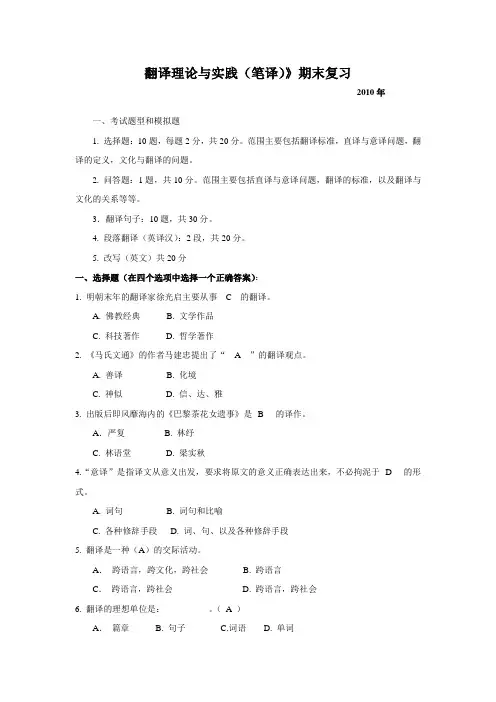
翻译理论与实践(笔译)》期末复习2010年一、考试题型和模拟题1. 选择题:10题,每题2分,共20分。
范围主要包括翻译标准,直译与意译问题,翻译的定义,文化与翻译的问题。
2. 问答题:1题,共10分。
范围主要包括直译与意译问题,翻译的标准,以及翻译与文化的关系等等。
3.翻译句子:10题,共30分。
4. 段落翻译(英译汉):2段,共20分。
5. 改写(英文)共20分一、选择题(在四个选项中选择一个正确答案):1. 明朝末年的翻译家徐光启主要从事---C---的翻译。
A. 佛教经典B. 文学作品C. 科技著作D. 哲学著作2. 《马氏文通》的作者马建忠提出了“---A---”的翻译观点。
A. 善译B. 化境C. 神似D. 信、达、雅3. 出版后即风靡海内的《巴黎茶花女遗事》是--B----的译作。
A.严复 B. 林纾C. 林语堂D. 梁实秋4.“意译”是指译文从意义出发,要求将原文的意义正确表达出来,不必拘泥于--D----的形式。
A. 词句B. 词句和比喻C. 各种修辞手段D. 词、句、以及各种修辞手段5. 翻译是一种(A)的交际活动。
A.跨语言,跨文化,跨社会 B. 跨语言C.跨语言,跨社会 D. 跨语言,跨社会6. 翻译的理想单位是:__________。
(A )A.篇章 B. 句子 C.词语 D. 单词7.下列四个语言特点中,----B--不是广告英语的特点。
A. 多祈使句B. 多后置定语C. 多新词汇D. 多常用词汇8. 鲁迅曾提出过“-------B--------”的翻译观点。
A. 宁顺而不信B. 宁信而不顺C. 与其信而不顺,不如顺而不信D. 忠实、通顺、得体9.“Do you see any green in my eye?”可以翻译为:__B_____。
A. 你从我的眼睛里看到绿颜色吗?B. 你以为我是好欺骗的吗?C. 你从我的眼睛里看到嫉妒的感觉吗?D. 你以为我在嫉妒你吗?10. “Last night I heard him driving his pigs to market.”意思为( B )。
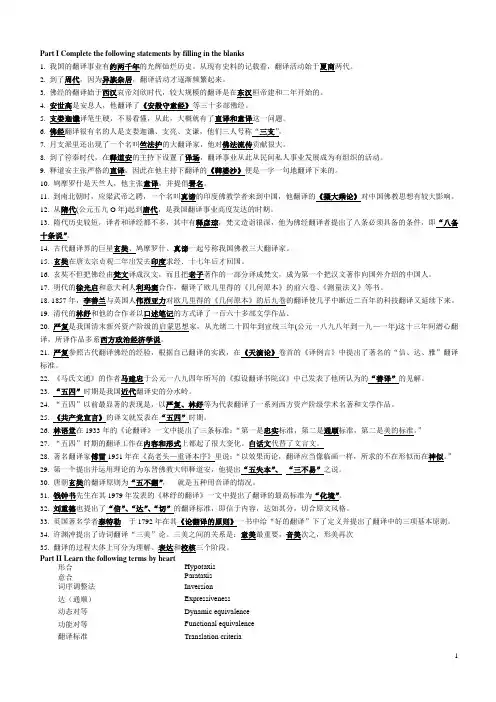
Part I Complete the following statements by filling in the blanks1. 我国的翻译事业有约两千年的光辉灿烂历史。
从现有史料的记载看,翻译活动始于夏商两代。
2. 到了周代,因为异族杂居,翻译活动才逐渐频繁起来。
3. 佛经的翻译始于西汉哀帝刘欣时代,较大规模的翻译是在东汉桓帝建和二年开始的。
4. 安世高是安息人,他翻译了《安般守意经》等三十多部佛经。
5. 支娄迦谶译笔生硬,不易看懂,从此,大概就有了直译和意译这一问题。
6. 佛经翻译很有名的人是支娄迦谶、支亮、支谦,他们三人号称“三支”。
7. 月支派里还出现了一个名叫竺法护的大翻译家,他对佛法流传贡献很大。
8. 到了符秦时代,在释道安的主持下设置了译场,翻译事业从此从民间私人事业发展成为有组织的活动。
9. 释道安主张严格的直译,因此在他主持下翻译的《鞞婆沙》便是一字一句地翻译下来的。
10. 鸠摩罗什是天竺人,他主张意译,并提倡署名。
11. 到南北朝时,应梁武帝之聘,一个名叫真谛的印度佛教学者来到中国,他翻译的《摄大乘论》对中国佛教思想有较大影响。
12. 从隋代(公元五九O年)起到唐代,是我国翻译事业高度发达的时期。
13. 隋代历史较短,译者和译经都不多,其中有释彦琮,梵文造诣很深,他为佛经翻译者提出了八条必须具备的条件,即“八备十条说”。
14. 古代翻译界的巨星玄奘、鸠摩罗什、真谛一起号称我国佛教三大翻译家。
15. 玄奘在唐太宗贞观二年出发去印度求经.十七年后才回国。
16. 玄奘不但把佛经由梵文译成汉文,而且把老子著作的一部分译成梵文,成为第一个把汉文著作向国外介绍的中国人。
17. 明代的徐光启和意大利人利玛窦合作,翻译了欧几里得的《几何原本》的前六卷、《测量法义》等书。
18. 1857年,李善兰与英国人伟烈亚力对欧几里得的《几何原本》的后九卷的翻译使几乎中断近二百年的科技翻译又延续下来。
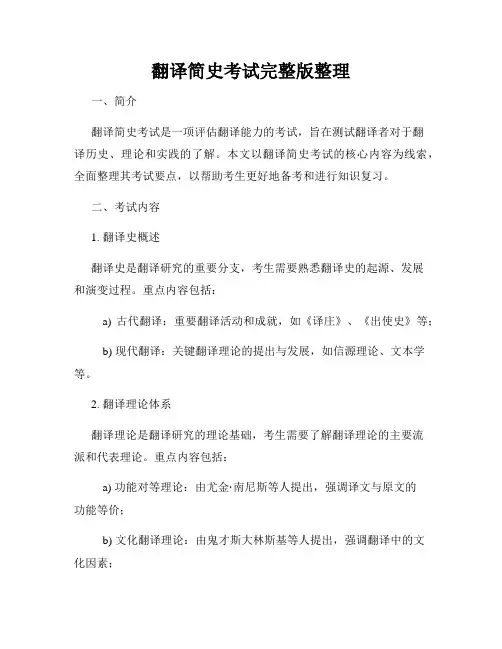
翻译简史考试完整版整理一、简介翻译简史考试是一项评估翻译能力的考试,旨在测试翻译者对于翻译历史、理论和实践的了解。
本文以翻译简史考试的核心内容为线索,全面整理其考试要点,以帮助考生更好地备考和进行知识复习。
二、考试内容1. 翻译史概述翻译史是翻译研究的重要分支,考生需要熟悉翻译史的起源、发展和演变过程。
重点内容包括:a) 古代翻译:重要翻译活动和成就,如《译庄》、《出使史》等;b) 现代翻译:关键翻译理论的提出与发展,如信源理论、文本学等。
2. 翻译理论体系翻译理论是翻译研究的理论基础,考生需要了解翻译理论的主要流派和代表理论。
重点内容包括:a) 功能对等理论:由尤金·南尼斯等人提出,强调译文与原文的功能等价;b) 文化翻译理论:由鬼才斯大林斯基等人提出,强调翻译中的文化因素;c) 办公性翻译理论:由久留米大学教授大野晓等人提出,强调职业翻译的特点和规范。
3. 翻译实践范式翻译实践是翻译研究的核心内容,考生需要了解翻译实践的不同范式和具体方法。
重点内容包括:a) 直译和意译:考生需要掌握直译和意译的区别和适用场景;b) 自由翻译和准确翻译:考生需要了解自由翻译和准确翻译的特点和要求;c) 文学翻译和科技翻译:考生需要熟悉文学翻译和科技翻译的特点和难点。
4. 翻译技巧与实战成功的翻译实践离不开合理的翻译技巧和实战经验。
考生需要了解常用的翻译技巧和实战策略。
重点内容包括:a) 语言转换和风格调整:考生需要熟练掌握语言转换和风格调整的技巧;b) 术语翻译和文化调整:考生需要学会处理术语翻译和文化调整的方法;c) 翻译评估和修改:考生需要掌握翻译评估和修改的技巧和要求。
三、备考建议1. 熟悉考试大纲:详细了解考试大纲中所列的知识点和要求,合理安排备考计划。
2. 注重理论与实践结合:既要掌握翻译史、理论体系等理论知识,又要注重翻译实践的积累和技巧应用。
3. 学习与交流互动:参加翻译培训班、研讨会等活动,与其他翻译者进行学习和交流。
翻译考试题库及答案一、单选题(每题2分,共20分)1. 翻译中“直译”和“意译”的主要区别在于:A. 直译更注重原文的字面意思,意译更注重原文的深层含义B. 直译更注重原文的深层含义,意译更注重原文的字面意思C. 直译和意译没有区别,都是翻译方法D. 直译和意译是同一种翻译方法的不同称呼答案:A2. 在翻译过程中,遇到文化差异导致的障碍时,应采取的策略是:A. 直接忽略文化差异,按照原文直译B. 完全按照目标语言的文化习惯进行调整C. 寻找文化共性,进行适当的文化适应D. 保持原文不变,让读者自行理解答案:C3. 翻译中的“忠实性”原则指的是:A. 忠实于原文的字面意思B. 忠实于原文的风格和语气C. 忠实于原文的内容和形式D. 忠实于原文的作者意图答案:C4. 下列哪个选项不是翻译中的常见问题?A. 语言障碍B. 文化差异C. 技术限制D. 信息过载答案:D5. 翻译中“等效性”原则主要强调的是:A. 译文与原文在形式上的相似性B. 译文与原文在内容上的相似性C. 译文与原文在效果上的相似性D. 译文与原文在风格上的相似性答案:C6. 在翻译中,如何处理专业术语?A. 直接使用原文中的专业术语B. 根据目标语言的习惯进行适当调整C. 忽略专业术语,使用通用词汇替代D. 创造新的词汇来描述专业术语答案:B7. 翻译中的“动态对等”理论是由哪位学者提出的?A. 尤金·奈达B. 彼得·纽马克C. 约翰·卡特福德D. 莱昂纳多·达·芬奇答案:A8. 在翻译中,如何处理原文中的双关语?A. 直接忽略B. 寻找目标语言中的对应双关语C. 保持原文不变,让读者自行理解D. 用注释的方式解释双关语的含义答案:B9. 翻译中的“功能对等”理论主要强调的是:A. 译文与原文在形式上的对等B. 译文与原文在功能上的对等C. 译文与原文在内容上的对等D. 译文与原文在风格上的对等答案:B10. 在翻译中,如何处理原文中的隐喻?A. 直接翻译成目标语言的字面意思B. 寻找目标语言中的对应隐喻C. 保持原文不变,让读者自行理解D. 用注释的方式解释隐喻的含义答案:B二、多选题(每题3分,共15分)11. 翻译中可能涉及的领域包括:A. 文学翻译B. 法律翻译C. 科技翻译D. 旅游翻译E. 以上都是答案:E12. 翻译中常见的错误类型包括:A. 语法错误B. 词汇错误C. 逻辑错误D. 风格错误E. 以上都是答案:E13. 翻译中常用的技巧包括:A. 增译B. 减译D. 直译E. 以上都是答案:E14. 翻译中可能遇到的挑战包括:A. 语言差异B. 文化差异C. 技术限制D. 个人偏好E. 以上都是答案:E15. 翻译中常用的工具包括:A. 词典B. 翻译软件D. 专业术语库E. 以上都是答案:E三、判断题(每题1分,共10分)16. 翻译是一种语言活动,与文化无关。
1.梁启超对我国的翻译事业主要有哪些贡献1创建大同议书局2翻译了(《佳人奇遇》、《俄皇宫之人鬼》、《十五小豪杰》、《世界末日记》)四部小说3编成《西学书目表》4引导翻译的潮流,培养翻译人才。
5重视我国的佛经翻译。
2 严复的译作主要包括哪几种?天演论原富群学肄言群己权界论社会通诠法意穆勒名学名学浅语中国教育议《天演论》敲响了亡国灭种的警钟,并且为人们提供了新的世界观和方法论;《原富》为中国人自强求富指明了方略;《群学肄言》强调了自然科学和社会科学对国家政治的指导作用;《社会通诠》向人们展示了由图腾社会到宗法社会,再到军国社会阶段的完整社会进化表;《法意》宣传的是自由民权学说,三权分立学说及君主立宪的好处;《穆勒名学》和《名学浅语》介绍了近代格物穷理的治学方法。
3 简述严复《天演论》的价值及影响。
●天演论以达尔文主义的科学性和说服力,给了当时中国人以振聋发聩的启蒙影响和难以忘怀的深刻印象。
●天演论刺激了中国人合群保种意识与现代民族主义的形成,为其后波澜壮阔的救亡运动做了一次社会总动员,在中国近代史上产生了持续而深远的影响。
●敲响了亡国灭种的警钟,并且为人们提供了新的世界观和方法论。
●严复在天演论的“译例言”中明确提出了“信、达、雅”三字翻译标准。
4. 简述信达雅的翻译标准意义信就是忠实于原文的意义;达就是使译文能让人看的懂;雅就是和原文的内容及体裁相称,要得体。
这三字标准,既不空洞,又不重叠,去一不可,添一不可,而在指导实践,检查实践效果上却最有效用,它是必要的,又是足够的。
6.简述林译茶花女遗事的影响茶花女遗事启发了人们想到婚姻自由,从而人们又觉悟到必须在更广泛的范围内反封建,起到了思想启蒙作用;茶花女遗事犹如一股清风,在中华民族“救亡图存”的大背景下,给沉闷的封建制的中国送来了新观念,激发了世人变革的热情。
8.林译小说产生了什么样的影响?第一,让中国人看到了一个生机勃勃、丰富多彩的世界。
中国历来实行“闭关锁国”的政策,令中国人了解不到外部世界的情况。
翻译史考试试题学习资料1. Explain the definition of translation and the concept of “formal correspondence” in the view of Catford.⑴Translation may be defined as follows: the replacement of textual material in one language (SL) by equivalent textual material in another language (TL).The use of the term “textual material” underlines the fact that in normal conditions it is not the entirety of a SL text which is translated, that is, replaced by TL equivalents. But at one or more levels of language there may be simple replacement, by non-equivalent TL material. Moreover, at one or more levels there may be no replacement at all, but simple transference of SL material into the TL text.The term “equivalent” is clearly a key term. The central problem of translation practice is that of finding TL translation equivalents. A central task of translation theory is that of defining the nature and conditions of translation equivalents.⑵A formal correspond ent is any TL category (unit, class, structure, etc.) which may be said to occupy, as nearly as possible, the “same” place in the economy of the TL as the given SL category occupies in the SL.Formal correspondence can be only approximate, and can only be established ultimately on the basis of textual equivalence at some point.3. What’s your understanding of “the nature of translation” in the light of Nida?According to Nida, the nature of translating is: Translating consists in reproducing in the receptor language the closest natural equivalent of the source-language message, first in terms of meaning and secondly in terms of style.Explanation of the Nature of the Translation (pp12-14)1. Translating must aim primarily at “reproducing the message”.T o do an ything else isessentially false to one’s task as a translator.(aim)2. The translator must strive for equivalence rather than identity. In a sense this is just another way of emphasizing the reproduction of the message rather than the conservation of the form of the utterance. (equivalence)3. The best translation does not sound like a translation. It should studiously avoid “translationese”—formal fidelity, with resulting unfaithfulness to the content and the impact of the message.(natural)4. A conscientious translator will want the closest natural equivalent because of the cultural differences.5. Meaning must be given priority, for it is the content of the message which is of prime importance for translating, and to do anything else is essentially false to one’s task as a translator.6. Style is said secondary to content, but it is still important. One should not translate poetry as though it were prose, nor expository material as though it were straight narrative.5. Explain “semantic translation” and “communicative translation” proposed by Newmark.①Semantic translation attempts to render, as closely as the semantic and syntactic structures of the second language allow, the exact contextual meaning of the original. Communicative translation attempts to produce on its readers an effect as close as possible to that obtained on the readers of the original.②Generally, a semantic translation tends to be more complex, more awkward, moredetailed, more concentrated, and pursues the thought-processes rather than the intention of the transmitter. It tends to overtranslate, to be more specific than the original, to include more meanings in its search for one nuance of meaning. A communicative translation is likely to be smoother, simpler, clearer, more direct, more conventional, conforming to a particular register of language, tending to undertranslate, i.e. to use more generic, hold-all terms in difficult passages.③A semantic translation is out of time and local space, wherea communicative translation is ephemeral and rooted in its context. A semantic translation attempts to preserve it s author’s idiolect, his peculiar form of expression. It relates to “expressive” function of language, where communicative translation responds to the vocative function of language.④One basic difference between the two methods is that where there is a conflict, the communicative must emphasize the “force” rather than the content of the message, e.g.: Beware of the dog!1) 当心狗!2)“狗咬人” 或“狗很凶”Keep off the grass!1)勿踏草坪!2)不要在草坪上行走。
翻译理论与实践考试题库一、选择题(每题2分,共20分)1. 翻译理论中的“信、达、雅”是由哪位翻译家提出的?A. 严复B. 林语堂C. 王力D. 钱钟书2. 在翻译过程中,哪种方法强调原文的忠实度?A. 直译B. 意译C. 音译D. 形译3. 翻译理论中,“功能主义”是由哪位学者提出的?A. 奈达B. 霍姆斯C. 斯奈尔-霍恩比D. 费舍尔4. 下列哪个选项不是翻译过程中可能遇到的问题?A. 文化差异B. 语言障碍C. 翻译技巧D. 语言风格5. 翻译理论中的“交际翻译”是指什么?A. 翻译者与原文作者的交流B. 翻译者与目标语言读者的交流C. 原文与译文的交流D. 原文与目标语言的交流6. 翻译理论中的“动态对等”是由哪位学者提出的?A. 奈达B. 霍姆斯C. 斯奈尔-霍恩比D. 费舍尔7. 在翻译实践中,哪种翻译策略更注重原文的文化内涵?A. 直译B. 意译C. 音译D. 形译8. 翻译理论中的“交际翻译”主要强调的是什么?A. 原文的忠实度B. 译文的流畅性C. 译文的可读性D. 译文的交际功能9. 翻译理论中的“翻译单位”通常指的是什么?A. 词汇B. 句子C. 段落D. 文章10. 在翻译实践中,哪种翻译方法更注重译文的可读性?A. 直译B. 意译C. 音译D. 形译二、简答题(每题10分,共30分)1. 简述翻译理论中的“交际翻译”与“语义翻译”的区别。
2. 描述翻译过程中如何处理文化差异,并举例说明。
3. 阐述翻译理论中的“功能主义”对翻译实践的影响。
三、论述题(每题25分,共50分)1. 论述翻译理论中的“动态对等”理论,并结合实际翻译案例进行分析。
2. 论述翻译实践中如何处理语言风格的差异,并给出具体的翻译策略。
四、翻译实践题(共30分)请将以下中文段落翻译成英文,并注意保持原文的语义、风格和文化内涵。
原文:随着全球化的不断深入,跨文化交流变得越来越重要。
翻译作为跨文化交流的重要工具,不仅要忠实于原文,还要考虑到目标语言的文化背景和读者的接受能力。
翻译理论与实践试题一、选择题(在四个选项中选择一个正确答案):20%1. 中国古代佛经翻译家------提出了“既须求真,又须喻俗”的翻译思想。
A. 鸠摩罗什B. 玄奘C.安世高D。
释道安2. 严复说的“一名之立,旬月踟躇”是指---------------------。
A. 翻译一部书要化一个月时间作准备B 翻译一个术语往往要考虑很久C.只有化苦功才能翻译成一部名著D.书名的翻译颇费思量3..下列四句,----句的表述是不正确的。
A. 鲁迅提出过“宁信而不顺”的翻译观点。
B. 马建忠主张“善译”的翻译标准。
C. 钱钟书认为文学翻译的最高标准是“化”。
D. 傅雷认为文学翻译的最高境界是“形似”。
4.下列四位翻译家中,英译《红楼梦》的是------。
A. 林语堂B. 杨宪益C. 杨必D. 鲁迅5.英国语言学家M.A.K.Halliday提出的构成语境三要素中,fields of discourse指---------------------------。
A. 交际内容B. 交际方式C. 交际风格D. 交际地点6. 多用被动语态是----------的一个比较明显的语法特点。
A. 广告英语B. 科技英语C. 新闻英语D. 法律英语7. “意译”是指译文从意义出发,要求将原文的意义正确表达出来,不必拘泥于------的形式。
A.词句B. 词句和比喻C. 各种修辞手段D. 词、句、以及各种修辞手段8.. ------翻译了莎士比亚的全部戏剧作品。
A. 朱生豪B. 卞之琳C. 梁实秋D. 林语堂9. fast, firm, secure三个同义词中,firm的正规程度介于前后两者之间,由此可以判定,它最有可能源自------。
A. 法语B. 拉丁语C.盎格鲁-撒克逊语D. 德语10. 下列四种“语体”中,--------的语言最为正规。
A. 广告英语B. 法律英语C. 新闻英语D. 科技英语二、问答题:30%1. 为什么严复要在他的翻译标准中加上一个“雅”字?你认为现在我们应该怎样理解这个“雅”字?2、.我们可以通过观察哪几种“语域标志”来区别英语语言的正规程度?请举例说明其中两种。
发给学生:中国、西方翻译历史(第一次测验复习题)中国、西方翻译历史填空1译界一般认为,我国有文字记载的翻译史当从东汉桓帝建和二年(公元148年)西域安息国人()到洛阳从事佛经翻译算起。
2支娄迦谶有位门生叫支亮,支亮有个弟子叫支谦。
三人均为月支国人,故并称(“”)。
3东晋初至隋末这一阶段佛经翻译家开始研究翻译理论,并出现了有组织的官办翻译机构,译经由私译开始转变为()。
4()在对般若经的各种版本进行了比较研究后,提出了“五失本,三不易”的理论。
就是说,翻译时有五种情况译文容易失去本来面目,有三种情况不易处理。
5彦琮,今河南省西平县人,我国隋朝的一位佛经翻译家及翻译理论家。
他在总结了自己和前人的译经经验,提出了译人(“”)。
6我国佛经翻译时期的特点是:一、时间长(前后长达一千多年);二、译量大;三、译者多为________ 。
7中国翻译史的第一时期,即佛经翻译时期,可分为______ 个阶段。
8同治元年(1862年)6月,因为精通外文的人才奇缺,清政府在北京成立了_____, 直属总理衙门。
这是一所培养翻译人员的外国语学校,也是一个官办翻译机构。
9翻译沙翁剧作成就最大、最有才华者,当推_____ 。
他在10年间共译出莎剧31个半,出版了《莎士比亚戏剧集》和《莎士比亚全集》。
10光绪二十七年(1901年),______ 改名为译学馆,并入京师大学堂。
11.1635—1637年意大利人艾儒略翻译的《天主降生言行记略》八卷本问世,成为______ 最早的汉语节译本。
12五四运动是我国近代翻译史的分水岭。
五四运动以后,我国的翻译事业进入了一个崭新的历史时期。
这一时期,马列主义经典著作和无产阶级文学作品开始被介绍到中国;翻译中,_______ 开始取代文言文;涌现出了以____ 为代表的无产阶级翻译家和翻译理论家。
13________ 翻译的高尔基的《海燕》达到了登峰造极、炉火纯青的程度。
这篇短短几百字的散文,竟数次修改,字斟句酌,前后达十年之久。
1. Explain the definition of translation and the concept of “formal correspondence” in the view of Catford.⑴Translation may be defined as follows: the replacement of textual material in one language (SL) by equivalent textual material in another language (TL).The use of the term “textual material” underlines the fact that in normal conditions it is not the entirety of a SL text which is translated, that is, replaced by TL equivalents. But at one or more levels of language there may be simple replacement, by non-equivalent TL material. Moreover, at one or more levels there may be no replacement at all, but simple transference of SL material into the TL text.The term “equivalent” is clearly a key term. The central problem of translation practice is that of finding TL translation equivalents. A central task of translation theory is that of defining the nature and conditions of translation equivalents.⑵A formal correspondent is any TL category (unit, class, structure, etc.) which may be said to occupy, as nearly as possible, the “same” place in the economy of the TL as the given SL category occupies in the SL.Formal correspondence can be only approximate, and can only be established ultimately on the basis of textual equivalence at some point.3. What’s your understanding of “the nature of translation” in the light of Nida?According to Nida, the nature of translating is: Translating consists in reproducing in the receptor language the closest natural equivalent of the source-language message, first in terms of meaning and secondly in terms of style.Explanation of the Nature of the Translation (pp12-14)1. Translating must aim primarily at “reproducing the message”.To do anything else isessentially false to one’s task as a translator.(aim)2. The translator must strive for equivalence rather than identity. In a sense this is just another way of emphasizing the reproduction of the message rather than the conservation of the form of the utterance. (equivalence)3. The best translation does not sound like a translation. It should studiously avoid “translationese”—formal fidelity, with resulting unfaithfulness to the content and the impact of the message.(natural)4. A conscientious translator will want the closest natural equivalent because of the cultural differences.5. Meaning must be given priority, for it is the content of the message which is of prime importance for translating, and to do anything else is essentially false to one’s task as a translator.6. Style is said secondary to content, but it is still important. One should not translate poetry as though it were prose, nor expository material as though it were straight narrative.5. Explain “semantic translation” and “communicative translation” proposed by Newmark.①Semantic translation attempts to render, as closely as the semantic and syntactic structures of the second language allow, the exact contextual meaning of the original. Communicative translation attempts to produce on its readers an effect as close as possible to that obtained on the readers of the original.②Generally, a semantic translation tends to be more complex, more awkward, moredetailed, more concentrated, and pursues the thought-processes rather than the intention of the transmitter. It tends to overtranslate, to be more specific than the original, to include more meanings in its search for one nuance of meaning. A communicative translation is likely to be smoother, simpler, clearer, more direct, more conventional, conforming to a particular register of language, tending to undertranslate, i.e. to use more generic, hold-all terms in difficult passages.③A semantic translation is out of time and local space, where a communicative translation is ephemeral and rooted in its context. A semantic translation attempts to preserve it s author’s idiolect, his peculiar form of expression. It relates to “expressive” function of language, where communicative translation responds to the vocative function of language.④One basic difference between the two methods is that where there is a conflict, the communicative must emphasize the “force” rather than the content of the message, e.g.:Beware of the dog!1) 当心狗!2)“狗咬人” 或“狗很凶”Keep off the grass!1)勿踏草坪!2)不要在草坪上行走。
Wet paint!1)“当心油漆!”或“油漆未干!” 2)油漆刚刚喷上。
⑤However, in communicative as in semantic translation, provided that equivalent-effect is secured, the literal word-for-word translation is not only the best, it is only valid method of translation.4. “Formal equivalence”, “dynamic equivalence”, and “functional equivalence” are thekey concepts in Nida’s theories of translation. How do you understand them?①Formal equivalence: a formal-equivalence translation is basically source-oriented; thatis, it is designed to reveal as much as possible of the form and content of the original message.In doing so, an F-E translation attempts to reproduce several formal elements, including: 1. grammatical units, 2. consistency in word usage, and 3. meanings in terms of the source context.The reproduction of grammatical units may consist in: a)translating nouns by nouns, verbs by verbs, etc.; b)keeping all phrases and sentences intact(i.e. not splitting up and readjusting the units); and c)preserving all formal indicators, e.g. marks of punctuation, paragraph breaks, and poetic indentation. In attempting to reproducing consistency in word usage, an F-E translation usually aims at so-called concordance of terminology; that is, it always renders a particular term in the source-language document by the corresponding term in the receptor document. In order to reproduce meanings in terms of the source context, an F-E translation normally attempts not to make adjustments in idioms, but rather to reproduce such expressions more or less literally, so that the reader may be able to perceive something of the way in which the original document employed local cultural elements to convey meanings.②Dynamic equivalence: in contrast, a translation which attempts to produce a dynamic rather than a formal equivalence is based on the principle of equivalent effect.In such a translation the focus of attention is directed toward the receptor response. O ne way of defining a D-E translation is to describe it as “the closest natural equivalent to the source-language message.” This type of definition contains three essential terms: 1) equivalent, which points toward the source-language message, 2) natural, which points toward the receptor language, and 3) closest, which binds the two orientations together on the basis of the highest degree of approximation.However, since a D-E translation is directly primarily toward equivalence of responserather than equivalence of form, it is important to define more fully the implications of the word “natural” as applied to such translation. Basically, the word “natural” is applicable to three areas of the communication process; for a natural rendering must fit 1) the receptor language and culture as a whole, 2) the context of the particular message, and 3) the receptor-language audience.③Functional equivalence: Basically, dynamic equivalence has been described in terms of functional equivalence. The translation process has been defined on the basis that the receptors of a translation should comprehend the translated text to such an extent that they can understand how the original receptors must have understood the original text. The expression “dynamic equivalence” has, however, led to some confusion, since the term “dynamic” has been understood merely in terms of something which has impact and appeal. Accordingly, to avoid misunderstanding the expression “functional equivalence” is employed, particularly since the twin bases for effective translation seem to be best represented in a sociosemiotic and sociolinguistic orientation, in which the focus is upon function.The translator must seek to employ a functionally equivalent set of forms which in so far as possible way will match the meaning of the original source-language text.6. Who is Cicero? Who is Schleiermacher? Who is Tytler? What are their views on translation respectively?⑴西塞罗(Cicero106—43B.C.)罗马演说家,哲学家,修辞学家,作家兼翻译家。